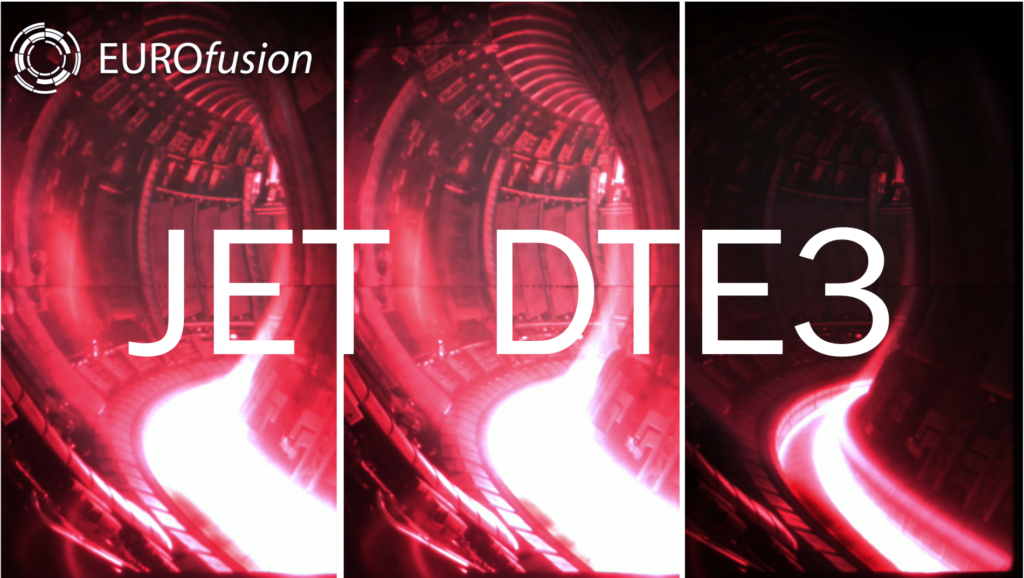
Garching, Germany, Thursday 23 November 2023 – EUROfusion announces the successful completion of its third and final deuterium-tritium experimental campaign (DTE3) at the Joint European Torus fusion device (JET). The experiments explored fusion processes and control techniques under similar conditions to and in preparation for future fusion power plants, marking an important leap ahead in our understanding of fusion plasmas.
The experimental campaign at JET was conducted by over 300 scientists participating in EUROfusion from across Europe together with engineering and scientific technical staff at the United Kingdom Atomic Energy Authority. JET is the only existing facility of its kind that can already operate with the high-performance deuterium-tritium fuel mix that will be used in future fusion power plants. While most fusion experiments use fuels like hydrogen or deuterium alone, testing with this deuterium-tritium mix is essential to get as close as possible to the conditions of a real fusion power plant.
The experiments at JET have optimized fusion reactions in deuterium-tritium and developed techniques to manage fuel retention, heat exhaust and materials evolution. This has generated crucial insights for the design and operation of future reactors like the international ITER experiment and the DEMO demonstration fusion power plant as well as for all other efforts worldwide to develop fusion power plants.
Tony Donné, Programme Manager (CEO) at EUROfusion, highlights, “These experiments at JET are a testament to the collaborative spirit and innovation in the EUROfusion community, paving the way for the next generation of fusion research and technology.”
EUROfusion’s experimental campaign at JET highlights Europe’s pivotal role in advancing fusion research and underscores its leadership in the global pursuit of clean, sustainable energy. This campaign marks a significant step forward in developing the technologies and methodologies essential for future fusion power plants.
Why This Experimental Campaign Matters:
- Bridging Past and Future in Fusion Research: The experimental campaign built on experiments at the end of 2021, enhancing our understanding of deuterium-tritium plasmas. This campaign’s insights into optimizing fusion reactions and developing novel operational strategies link past learnings with future applications in fusion technology.
- Validating Physics Across Scales and Fuels: Researchers tested new concepts developed in smaller European tokamaks in JET, initially with deuterium and then with a deuterium-tritium fuel mix. This research is key to help understand how processes observed in smaller devices will scale to larger future fusion projects.
- Advancing Tritium Fuel Management: JET has made significant strides in managing the fuel component tritium, pioneering novel monitoring and cleaning technologies including laser-based diagnostic methods like LID-QMS (Laser Induced Desorption – Quadrupole Mass Spectrometry). These innovations are crucial for ITER’s future operations, ensuring accurate tritium accountancy and enhancing operational safety.
- Replicating Operational Scenarios: A major success of the DTE3 campaign was its ability to replicate the high-fusion-energy experiments from 2021’s second deuterium-tritium experimental campaign (DTE2). This accomplishment highlights the reliability and maturity of JET’s operational methodologies that are essential for the ITER project’s future success.
- Integrated Scenarios with Compatible Exhaust Solutions: The campaign involved testing diverse operational scenarios to efficiently manage heat exhaust from the hot, ionised gas fuel (plasma). Researchers focused on dispersing energy at the plasma edge while maintaining high energy levels in the plasma core, a critical balance for reactor feasibility. This included minimizing or eliminating energy outbursts from plasma edge instabilities and implementing innovative heat load management techniques like feedback-controlled impurity gas injections to create a localised radiator plasma zone around the X-point. Additionally, the team demonstrated real-time control of the D-T fuel mix by injecting gas and frozen deuterium pellets, a key method for controlling fusion reactions. These advancements are instrumental for the successful operation of future fusion reactors.
- Enhancing Knowledge of High-Energy Neutron Effects: Focusing on the impact of fusion-born 14.1 MeV neutrons that carry the energy from fusion reactions out of the plasma, the campaign provided insights into their effects on cooling systems and electronics, the latter in collaboration with CERN. This knowledge is essential for designing safe, more efficient future fusion reactors.
The Joint European Torus (JET) is a fusion experiment of the donut-shaped tokamak design located at Culham Centre for Fusion Energy in Oxfordshire, UK. The facility uses magnetic fields to keep the hot, ionised gas (plasma) away from the vessel’s interior walls, enabling safe operation at 150 million degrees Celsius – ten times the temperature at the core of the Sun.
JET commenced operation in 1983 as a joint European project, undergoing several enhancements to improve its performance over the years. In 1991, JET became the world’s first reactor to operate using a 50–50 mix of tritium and deuterium. The facility set numerous fusion records including a record Q-plasma (the ratio of the fusion power produced to the external power put in to heat the plasma) of 0.64 in 1997 and a fusion energy record output of 59 megajoules in a five-second pulse in December 2021. Built by Europe and used collaboratively by European researchers over its lifetime, JET became UKAEA property in October 2021, celebrated its 40th anniversary in June this year, and will cease operations at the end of 2023.
